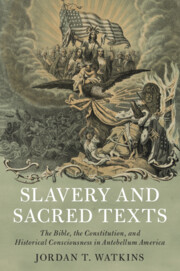 Slavery and Sacred Texts
Slavery and Sacred Texts Published online by Cambridge University Press: 12 June 2021
The Dred Scott decision embodied how the debates over slavery held unique potential to deepen Americans’ awareness of historical distance. In his decision, Chief Justice Roger B. Taney accepted the historical grounds of debate that had been prepared through decades of interpretive emphasis on the historical explication. He then argued that because the founders had not considered blacks as citizens in 1787, blacks could not be citizens in 1857. In this reading, Taney forcefully rejected the antislavery idea that the progress of moral insight demanded new constitutional readings. However, in their dissenting opinions, John McLean and Benjamin Curtis gave official credence to much of that antislavery idea. They suggested that the Constitution could be adapted in light of original expectations of abolition. These opinions, along with political and popular responses to the decision, accelerated a growing sense that more than just chronological difference separated nineteenth-century Americans from their revolutionary predecessors. In their appeals to the founding era, the justices and their respondents highlighted unmistakable historical differences between that past and their present.
To save this book to your Kindle, first ensure [email protected] is added to your Approved Personal Document E-mail List under your Personal Document Settings on the Manage Your Content and Devices page of your Amazon account. Then enter the ‘name’ part of your Kindle email address below. Find out more about saving to your Kindle.
Note you can select to save to either the @free.kindle.com or @kindle.com variations. ‘@free.kindle.com’ emails are free but can only be saved to your device when it is connected to wi-fi. ‘@kindle.com’ emails can be delivered even when you are not connected to wi-fi, but note that service fees apply.
Find out more about the Kindle Personal Document Service.
To save content items to your account, please confirm that you agree to abide by our usage policies. If this is the first time you use this feature, you will be asked to authorise Cambridge Core to connect with your account. Find out more about saving content to Dropbox.
To save content items to your account, please confirm that you agree to abide by our usage policies. If this is the first time you use this feature, you will be asked to authorise Cambridge Core to connect with your account. Find out more about saving content to Google Drive.